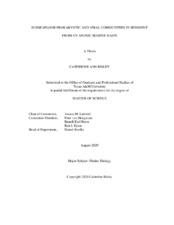| dc.description.abstract | Prokaryotes make up the majority of the biomass in sediment, where they play a role in cycling organic carbon and regulate the fluctuation of organic matter. Studies of abundance, genomic composition, and ecological roles of prokaryotes and viruses indicate that viruses are significant contributors to subseafloor ecosystems. In anoxic coastal sediment, the availability of electron donors and acceptors could be an important driver of the microbial community composition and functionality. The main goal of this study was to define the relationships between prokaryotic diversity and activity, nutrient availability, and organic matter source within sediment of an anoxic basin (Blackwood Sinkhole, Bahamas), to determine their roles in biogeochemical processes. The main goal was achieved by answering the following specific objectives: (1) determine the source of carbon in a 0.9 m long core dated to ~2,500 years, (2) define the relationship between the origin of carbon and microbial community composition, (3) characterize the diversity and analyze the functionality of prokaryotes from an anoxic sinkhole basin, and (4) determine the availability of electron donors and acceptors and their relation with microbial genomic potential and activity, using viral production and virus-induced microbial mortality as a proxy for microbial activity. The source of carbon, whether terrestrial or planktonic, impacted the microbial community composition as there was a significant correlation between the microbial community abundance and the C:N ratio. Genes involved in sulfate reduction, sulfur oxidation and denitrification were among the main metabolisms found. The rate of viral production and virus-induced microbial mortality was linked to nutrient concentration. These results show that the microbial community present (Bacteria, Archaea, and viruses) and their interactions with nutrients available in anoxic sinkhole sediment may play an important role in the global sulfur, nitrogen, and carbon cycles. | en |


